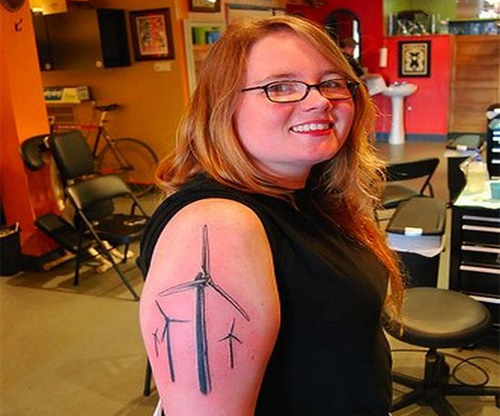VINALHAVEN – A year ago, Fox Islands Wind began operating wind turbines on Vinalhaven Island. As a result, a community effort that began with eager anticipation is now tarnished.
As a neighbor of the wind turbine farm, this year has been a journey from hope to anger and disgust. Fox Islands Wind continues to misrepresent and mislead our community while using its authority to bully state regulators on the issue of violating noise standards.
Our experience has forced me to look into the deeper issues of industrial wind — the technology, the economics and the politics. It has been an uncomfortable journey that has changed my once honey-eyed vision of easy, green power to a view that industrial wind energy is, at present, bad science, bad economics and bad politics.
I add my voice to the growing number of Mainers who are demanding a moratorium on wind projects all over Maine.
Jonathan Carter, once an advocate for wind power, travels statewide to expose the arrogant destruction of mountaintops. David P. Corrington, a registered Maine Master Guide, has a new website, realwindinfoforme.org, that provides information about grid-scale industrial wind power development nationwide and industrial wind in Maine.
And there are the many voices of the residents of Camden, Montville, Bucksfield, Thorndike, Jackson and Dixmont who have repelled the efforts to locate windmills in their towns.
These voices, and countless others, are shouting truth in response to the half-truths, misrepresentations and distortions of wind developers.
Wind energy proponents continue to demand that we provide them with unprecedented resources and that we waive basic, traditional rights to discussion and debate.
They undermine local autonomy, enjoyment of property, and health and safety. They thumb their noses at environmental compliance and demand that citizens forgo normal, time-honored mechanisms of due process.
So, we must ask a simple question: How many more years will citizens be expected to pay, and what rights will we have to surrender, to benefit an unproven technology and the smoke-and-mirror economics that seem to be the foundation of industrial wind?
George Baker, vice president for community wind at the Island Institute and CEO of Fox Islands Wind, must be held responsible for the damages inflicted on our community. His Island Institute website says, “We will demonstrate how wind projects in the coastal area can be sited without adverse environmental and aesthetic impacts, and provide long-term economic benefits for local residents.”
Their failure to demonstrate success has placed our quiet community on the front pages of the nation’s top newspapers, including The New York Times.
How can the institute’s formula of 70 percent acceptance be deemed a success? What happens to the other 30 percent of us? Dismissed? Excused? Collateral damage?
Where do our neighbors find the money that has been stolen from them in lowered property values that they will never be able to recover? What happens with the increasing medical bills that families must shoulder from the stress of living with days filled with tortuous light flicker and sleepless nights of low-frequency rumblings?
How can the Island Institute justify Fox Islands Wind’s preposterous use of the ridiculous efforts of the National Renewable Energy Laboratories, compiling data from summer residents with an experiment that started in October?
How can anyone call this past year a success when Fox Islands Wind refuses to share financial information to show exactly where the purported savings are coming from and what the projections for the next several years might be?
I know that the Baker/Island Institute strategy is to wear the neighbors down. That is not going to happen. It gives us strength to know that, while Baker, the Island Institute and their cronies congratulate themselves in their boardrooms, they should be aware the nation is watching them with a jaundiced eye.
After this long year I can only shake my head and say: Shame on the Island Institute, shame on Fox Islands Wind, shame on all the other wind projects that are changing the face of Maine for the profit of a few ex-governors, ex-public utility chairmen and ex-Harvard professors.
Cheryl Lindgren is a member of Fox Islands Wind Neighbors, a group of concerned residents working toward responsible renewable energy on Vinalhaven.
THIRD FEATURE:
WIND TURBINES FORCE GLENBRAE FAMILY OUT OF HOME
November 12 2010
BRENDAN GULLIFER
Glenbrae farming couple Carl and Sam Stepnell walked away from their nine-year-old home last week, claiming turbines near their property were making them sick.
Mr Stepnell, 39, said the family had bought a second home in Ballarat, and now return to the property during the day to run the family farm.
“Our parents are in their seventies and live at the other end of the place,” Mr Stepnell said yesterday.
“For Dad to pull over at the shed, come over here and have a cuppa… and his grand kids aren’t here.
“The heart and soul has gone out of our home, which was us and our kids.”
Mrs Stepnell, 37, said she began to suffer symptoms immediately after turbines were turned on near her house 14 months ago.
“I’ve never suffered anything like it before,” she said.
“Instant pressure in the ears and in the head, inability to sleep.
“The trouble is that it is not like a broken arm or leg. You can’t see it.
“Some nights the noise was unbearable. You cannot relax. You can’t get to sleep.”
Mr Stepnell said he suffered symptoms more slowly than his wife, but after eight months he was regularly experiencing heart palpitations, “weird sensations.
“It just didn’t feel right,” he said.
The couple built their home nine years ago on the family farm.
They said they conferred with their doctor but felt there was no other option but to move out.
Mr Stepnell said all symptoms had immediately abated since they stopped sleeping at their Lobbs Road home.
He said they had declined to have wind turbines on their property when the wind farm was being planned because they were aware of alleged health problems.
The Waubra Wind Farm comprises 128 wind turbines, about 35kms north west of Ballarat.
Earlier this year the federal government’s National Health and Medical Research Council found no published scientific evidence linking wind turbines with illness.
FOURTH FEATURE:
GAGGED PROPERTY OWNERS URGED TO GIVE EVIDENCE
SOURCE The Courier, www.thecourier.com.au
November 12 2010
BRENDAN GULLIFER,
Property owners gagged by wind turbine companies will be able to give evidence to a Federal Senate inquiry.
Family First Senator Steve Fielding was in Glenbrae yesterday to encourage locals to make submissions to the inquiry into the social and economic impact of wind farms in rural areas.
Standing against a backdrop of rotating Waubra wind turbines, Senator Fielding said it would be a “real concern” if anyone was gagged from coming forward on the issue.
“Clearly people in this region, in Waubra and beyond, haven’t been heard and this is your chance to have your say,” Senator Fielding told a group of about 20 residents.
“I don’t know of any other country at the federal level having an inquiry like this.
“If a confidential agreement has been made you have to honor that as well, but it would be a shame not to hear views in a way that doesn’t reveal details.”
Under Senate inquiry rules, a person is prohibited from inducing another person to refrain from giving evidence.
Senate inquiries also carry Parliamentary privilege and evidence may be given confidentially.
It is understood further advice is being sought in relation to confidentiality agreements signed with wind farm companies, and Senator Fielding said he will make further investigations into the matter.
The meeting was held at the former home of Carl and Sam Stepnell.
Mr and Mrs Stepnell and their three children relocated to Ballarat last week due to claimed adverse health effects from living in close proximity to turbines.
“We couldn’t handle it any more,” Mr Stepnell said after the meeting. “All the symptoms…”
Mr Stepnell said the house had five turbines located within a kilometre.
Meanwhile, the Clean Energy Council was in Ballarat this week with a report confirming that noise from wind farms does not have any adverse health effects.
FIFTH FEATURE:
SYMPOSIUM DELIVERS FACTS ON WIND ENERGY
SOURCE: http://countylive.ca/blog/?p=7647
November 11, 2010
by Henri Garand, Alliance to Protect Prince Edward County (APPEC)
The First International Symposium on the Global Wind Industry and Adverse Health Effects, held this past weekend in Picton, brought together American, British and Canadian acousticians, physicists, physicians, and medical researchers. The audience came from across Ontario and the United States and from as far as Australia.
Our understanding of how wind turbines can affect human health is steadily increasing. Since the facts often contradict the Ontario government’s and wind industry’s claims, it may be useful to clarify the current state of knowledge.
1. Claim: Ontario’s regulations are the best in the world.
FACTS: Orville Walsh, CCSAGE chair and APPEC vice president, studied government regulations in every country hosting wind turbines. The standards differ widely and most are based on noise, not setback distances. Ontario’s noise level is 40 dbA, measured outside a home. Countries, like Germany, with lower levels cite either 35 dbA or +3 dbA above ambient sound. Night time ambient sound in a rural area is typically 30 dbA or less. (On the dbA scale, the ear can detect a difference of +/- 2-3 decibels and perceives 10 decibels as a doubling of sound.)
2. Claim: The sounds heard from wind turbines are no louder than whispers or a refrigerator.
FACTS: Dr. John Harrison, a physicist, explained that wind turbine sounds, especially the “swoosh,” are different because of their amplitude and can exceed the 40 dbA regulatory limit because turbine sitings are based on computer models, not live measurements. Moreover, turbine noise is not masked by natural sounds and can sometimes be perceived over great distances. Depending on weather conditions and cloud cover, a large installation of wind turbines, such as those planned for Lake Ontario, could emit over 40 dbA of noise as far as 9-15 km away.
3. Claim: Wind Turbines do not produce low-frequency sound.
FACTS: Acoustician Rick James exhibited spectrograms of the sound coming from land-based wind turbines in which the low-frequency component was substantial and could be measured more than 5 km away. He also compared the symptoms of people suffering from “Wind Turbine Syndrome” to the identical symptoms reported in the 1970’s and 80s by those working in so-called “sick buildings.” The latter problem was eventually identified as due to infra low-frequency sound (ILFN) transmitted through ducting.
4. Claim: People cannot detect infrasound.
FACTS: Dr. Alex Salt, a physiologist, described his recent research findings in which parts of the inner ear reacted visibly to infrasound. His research shows that the ear does respond to low-frequency sound even though we do not perceive it as sound. Further research will be required to understand how these impulses are transmitted to the brain, with possible disturbance and detrimental effects.
5. Claim: Complaints about wind turbine noise indicate annoyance, which is harmless.
FACTS: Dr. Arline Bronzaft, a noise researcher, explained how daytime transit noise near a New York City public school went well beyond annoyance and affected students’ academic achievement. The effects of noise disturbance are not restricted to nighttime, and the effects of noise on children can be profound, impacting development.
6. Claim: Wind turbine noise is harmless.
FACTS: Dr. Christopher Hanning, a specialist in Sleep Medicine, explained how noise can disrupt the sleep patterns necessary for health and how loss of sleep affects memory and thinking, and can lead in the long term to risks of diabetes and heart disease.
Dr. Nina Pierpont, a physician and researcher and author of Wind Turbine Syndrome, explained how auditory systems react to sound and the negative effects of wind turbine sound on the patients she has studied.
7. Claim: Wind turbine noise affects few people seriously.
FACTS: Dr. Michael Nissenbaum reported on his studies of people living near wind projects in Mars Hill and Vinalhaven, Maine. Both studies indicate that residents within 2 km and beyond, compared to a control group outside the project areas, suffered serious sleep disturbance and stress.
8. Claim: Wind turbines are safe because no peer-reviewed studies prove otherwise.
FACTS: Dr. Carl Phillips, an epidemiologist, explained that clinical reports around the world are sufficient evidence of adverse health effects and that wind industry denials reflect misunderstanding of the stages of scientific inquiry and the value of peer review.
9. Claim: Wind development serves the public good.
FACTS: Carmen Krogh, board member of the Society for Wind Vigilance, applied the concept of social justice to public health and presented testimonies from Ontario, Germany, and Japan of people suffering from wind projects. Ontario rural residents are dismayed, to put it mildly, that every government agency has ignored their plight.
10. Claim: Ontario’s Green Energy Act is unchallengeable.
FACTS: Lawyer Eric Gillespie outlined the legal actions Ontario residents can take against wind development, including the appeal process for the Ministry of Environment’s Renewable Energy Approval of projects. Appeals, however, must meet a high standard by proving that harm to health is serious or harm to the environment is both serious and irreversible. By contrast, the Ian Hanna case has only to prove scientific uncertainty about the harm to human health.
11. Claim: Wind development saves lives by closing coal-burning electricity plants.
FACTS: Economist Dr. Ross McKitrick reported that Ontario’s air pollution has declined steadily since the 1960s and that, according to data from government measuring stations, coal-related emissions are no more than one part per billion. Statistics of 250 to 9,000 Ontario deaths annually related to coal burning are based on dubious computer models from elsewhere; they are not founded on actual certificates of death. There is simply no problem on which wind energy development could have a positive effect.
12. Claim: Wind Energy Development is a solution to the Need for Electricity.
FACTS: Journalist Robert Bryce, author of Power Hungry: The Myths of Green Energy and the Real Fuels of the Future, described society’s need for reliable electric power, not intermittent, variable wind energy. Since there is no technology for mass storage of electricity, the power produced from wind cannot contribute substantially to electricity supply, let alone replace base load.
Considering the adverse health effects and practical limitations of wind energy, how is it that wind development remains so popular? The answer lies in twenty years of social marketing, environmental fears, and the false economic hope of green jobs. The Symposium should make everyone question what the Ontario government and wind industry would like us to believe.





